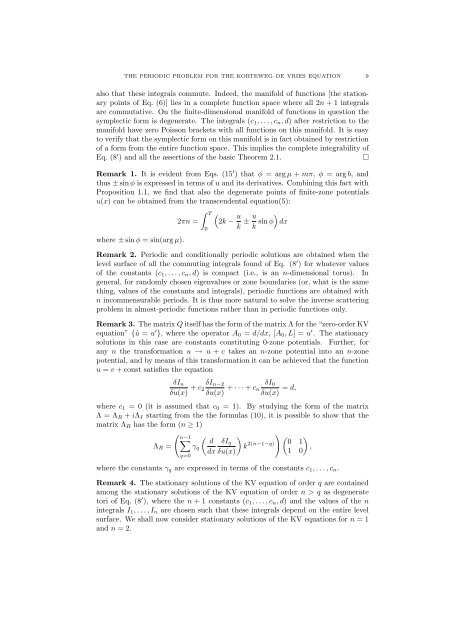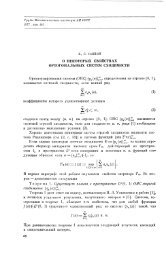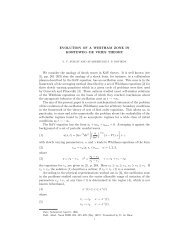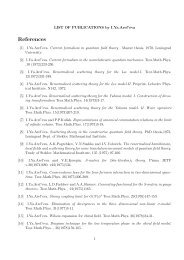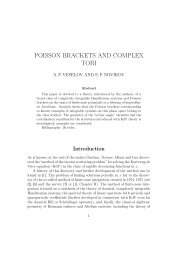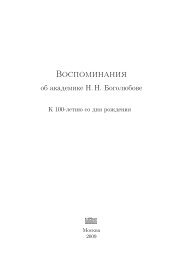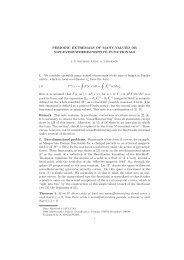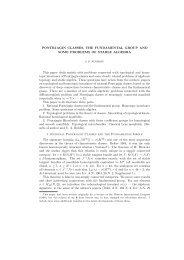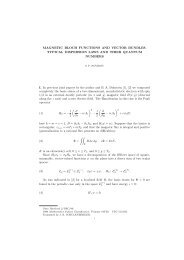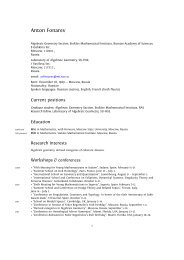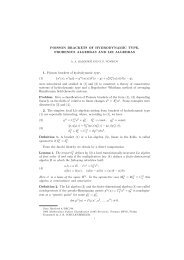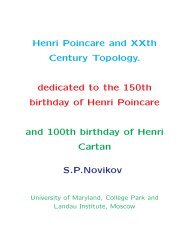A periodic problem for the Korteweg-de Vries equations, I.
A periodic problem for the Korteweg-de Vries equations, I.
A periodic problem for the Korteweg-de Vries equations, I.
Create successful ePaper yourself
Turn your PDF publications into a flip-book with our unique Google optimized e-Paper software.
THE PERIODIC PROBLEM FOR THE KORTEWEG–DE VRIES EQUATION 9also that <strong>the</strong>se integrals commute. In<strong>de</strong>ed, <strong>the</strong> manifold of functions [<strong>the</strong> stationarypoints of Eq. (6)] lies in a complete function space where all 2n + 1 integralsare commutative. On <strong>the</strong> finite-dimensional manifold of functions in question <strong>the</strong>symplectic <strong>for</strong>m is <strong>de</strong>generate. The integrals (c 1 , . . . , c n , d) after restriction to <strong>the</strong>manifold have zero Poisson brackets with all functions on this manifold. It is easyto verify that <strong>the</strong> symplectic <strong>for</strong>m on this manifold is in fact obtained by restrictionof a <strong>for</strong>m from <strong>the</strong> entire function space. This implies <strong>the</strong> complete integrability ofEq. (8 ′ ) and all <strong>the</strong> assertions of <strong>the</strong> basic Theorem 2.1.□Remark 1. It is evi<strong>de</strong>nt from Eqs. (15 ′ ) that φ = arg µ + mπ, φ = arg b, andthus ± sin φ is expressed in terms of u and its <strong>de</strong>rivatives. Combining this fact withProposition 1.1, we find that also <strong>the</strong> <strong>de</strong>generate points of finite-zone potentialsu(x) can be obtained from <strong>the</strong> transcen<strong>de</strong>ntal equation(5):where ± sin φ = sin(arg µ).2πn =∫ T0(2k − u k ± u k sin φ )dxRemark 2. Periodic and conditionally <strong>periodic</strong> solutions are obtained when <strong>the</strong>level surface of all <strong>the</strong> commuting integrals found of Eq. (8 ′ ) <strong>for</strong> whatever valuesof <strong>the</strong> constants (c 1 , . . . , c n , d) is compact (i.e., is an n-dimensional torus). Ingeneral, <strong>for</strong> randomly chosen eigenvalues or zone boundaries (or, what is <strong>the</strong> samething, values of <strong>the</strong> constants and integrals), <strong>periodic</strong> functions are obtained withn incommensurable periods. It is thus more natural to solve <strong>the</strong> inverse scattering<strong>problem</strong> in almost-<strong>periodic</strong> functions ra<strong>the</strong>r than in <strong>periodic</strong> functions only.Remark 3. The matrix Q itself has <strong>the</strong> <strong>for</strong>m of <strong>the</strong> matrix Λ <strong>for</strong> <strong>the</strong> “zero-or<strong>de</strong>r KVequation” { ˙u = u ′ }, where <strong>the</strong> operator A 0 = d/dx, [A 0 , L] = u ′ . The stationarysolutions in this case are constants constituting 0-zone potentials. Fur<strong>the</strong>r, <strong>for</strong>any n <strong>the</strong> trans<strong>for</strong>mation u → u + c takes an n-zone potential into an n-zonepotential, and by means of this trans<strong>for</strong>mation it can be achieved that <strong>the</strong> functionu = v + const satisfies <strong>the</strong> equationδI nδu(x) + c δI n−22δu(x) + · · · + c δI 0nδu(x) = d,where c 1 = 0 (it is assumed that c 0 = 1). By studying <strong>the</strong> <strong>for</strong>m of <strong>the</strong> matrixΛ = Λ R + iΛ I starting from <strong>the</strong> <strong>the</strong> <strong>for</strong>mulas (10), it is possible to show that <strong>the</strong>matrix Λ R has <strong>the</strong> <strong>for</strong>m (n ≥ 1)Λ R =( n−1 ∑( dγ qdxq=0δI qδu(x)) ) (0 )k 2(n−1−q) 1,1 0where <strong>the</strong> constants γ q are expressed in terms of <strong>the</strong> constants c 1 , . . . , c n .Remark 4. The stationary solutions of <strong>the</strong> KV equation of or<strong>de</strong>r q are containedamong <strong>the</strong> stationary solutions of <strong>the</strong> KV equation of or<strong>de</strong>r n > q as <strong>de</strong>generatetori of Eq. (8 ′ ), where <strong>the</strong> n + 1 constants (c 1 , . . . , c n , d) and <strong>the</strong> values of <strong>the</strong> nintegrals I 1 , . . . , I n are chosen such that <strong>the</strong>se integrals <strong>de</strong>pend on <strong>the</strong> entire levelsurface. We shall now consi<strong>de</strong>r stationary solutions of <strong>the</strong> KV <strong>equations</strong> <strong>for</strong> n = 1and n = 2.


